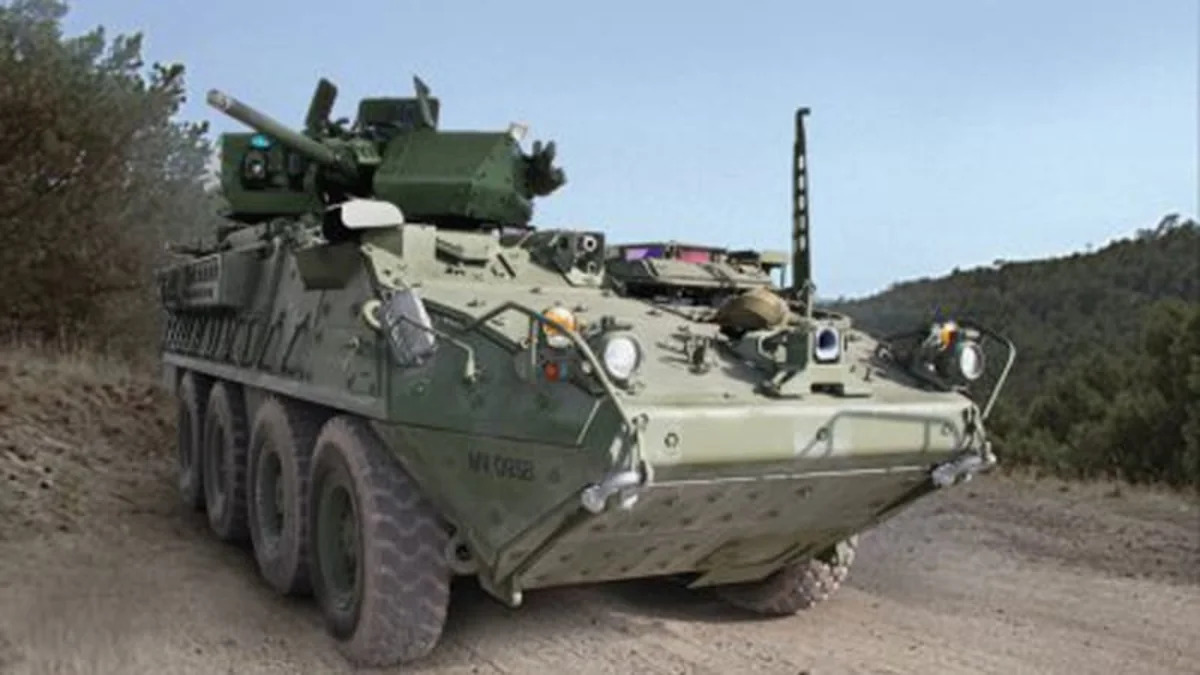This post is appearing on Autoblog Military, Autoblog's sub-site dedicated to the vehicles, aircraft and ships of the world's armed forces.
The general idea behind an armored personnel carrier like the IAV Stryker is simple – they scout ahead of a larger force and occasionally deal with soft infantry targets. Neither mission requires much firepower. But with Russia acting increasingly belligerent, Army Vice Chief of Staff Gen. Daniel B. Allyn said the service "identified a capability gap that threatened our forces in theater." And that's why we're seeing a Stryker with a hearty 30-millimeter cannon on the top.
"The Russians, it turns out, had upgraded and fielded significant capabilities while we were engaged in Iraq and Afghanistan," Gen. Allyn said, referring to the Russian BMP-2 and BMP-3 tracked fighting vehicle. The Stryker's two rivals started carrying 30-mm cannons – and in the BMP-3's case, a 100-mm launcher – while the American vehicle was stuck with an unarmored turret and a .50-caliber machine gun. Army leaders called that firepower differential an "unacceptable risk."
The new Stryker, which General Dynamics Land Systems just delivered to the Army in prototype form, carries a 30-mm cannon in an armored, remote-control turret. That's good for the tank's crew, which no longer needs to expose themselves to operate the gun. While the extra firepower is impressive, the fact that General Dynamics brought the first prototype to bear so quickly is even more exciting.
The Army only submitted an "Urgent Operational Needs statement" for a deadlier Stryker 19 months ago. And with the first prototype finally in Army hands, it looks like the service will actually deliver on its promised May 2018 deployment date for the 30-mm Stryker. The 2nd Cavalry Regiment in Europe has first dibs on the upgunned Stryker, likely in a bid to further deter the Russian military.
The general idea behind an armored personnel carrier like the IAV Stryker is simple – they scout ahead of a larger force and occasionally deal with soft infantry targets. Neither mission requires much firepower. But with Russia acting increasingly belligerent, Army Vice Chief of Staff Gen. Daniel B. Allyn said the service "identified a capability gap that threatened our forces in theater." And that's why we're seeing a Stryker with a hearty 30-millimeter cannon on the top.
"The Russians, it turns out, had upgraded and fielded significant capabilities while we were engaged in Iraq and Afghanistan," Gen. Allyn said, referring to the Russian BMP-2 and BMP-3 tracked fighting vehicle. The Stryker's two rivals started carrying 30-mm cannons – and in the BMP-3's case, a 100-mm launcher – while the American vehicle was stuck with an unarmored turret and a .50-caliber machine gun. Army leaders called that firepower differential an "unacceptable risk."
The new Stryker, which General Dynamics Land Systems just delivered to the Army in prototype form, carries a 30-mm cannon in an armored, remote-control turret. That's good for the tank's crew, which no longer needs to expose themselves to operate the gun. While the extra firepower is impressive, the fact that General Dynamics brought the first prototype to bear so quickly is even more exciting.
The Army only submitted an "Urgent Operational Needs statement" for a deadlier Stryker 19 months ago. And with the first prototype finally in Army hands, it looks like the service will actually deliver on its promised May 2018 deployment date for the 30-mm Stryker. The 2nd Cavalry Regiment in Europe has first dibs on the upgunned Stryker, likely in a bid to further deter the Russian military.


Sign in to post
Please sign in to leave a comment.
Continue